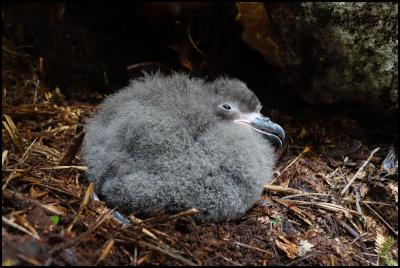Record breeding season for Chatham Island tāiko
Record breeding season for Chatham Island tāiko

This year’s
Chatham Island tāiko breeding season has produced a record
number of chicks. 22 birds hatched from 26 eggs, blowing the
previous record of 13 chicks out of the water.
The Chatham Island tāiko is one of New Zealand’s most endangered species, with less than 150 birds left. They were thought to be extinct for almost a century until they were rediscovered by David Crockett in 1978. It wasn’t until 10 years later that the first signs of breeding were found on a remote corner of the Chathams.
Chatham Island Tāiko Trust coordinator Mike Bell is thrilled with the news and says it will be a great step towards protecting these critically endangered petrels.
“For a bird as endangered as tāiko – it’s an amazing boost. There are only 26 pairs of these birds in the whole world (the rest are too young to breed), so every chick counts in protecting and building the population.”
The breeding season was not without drama as the 22nd chick to hatch was raised as a “foster egg” after it was left by a pair of first-time breeders who laid the egg in the wrong part of the burrow.
“We suspect they weren’t ready to breed because they didn’t lay their egg in the chamber of the burrow like usual. It looks like the female literally dumped the egg and left, then the male just stood around outside their burrow and didn’t sit on the egg for about 10 days before going off out to sea.”
One of the Taiko Trust staff members found the exposed egg, put it in his lunchbox, and quickly rushed it over to another pair who were sitting on an egg, which they had previously damaged.
“These birds live in a burrow 3 metres deep – it’s completely dark in there and one of the parents could have accidentally stood on the egg or knocked it around a bit. It’s a dangerous life for a seabird egg or chick” says Mike Bell.
“We weren’t even sure if the egg was fertile, but left it for a month then put a light behind it to see if there was a foetus – and there was! It was very exciting!”
But the new egg was laid much later than the foster parent’s original egg, so they had to stay in the burrow to incubate the egg for an extra two weeks.
“We hoped for two weeks that they wouldn’t give up and stay on the egg. It was quite nerve-wracking. We checked every day to make sure an adult was still on the egg.”
Finally the foster egg hatched earlier this week, signalling the final phase of this year’s breeding season. From now, the chicks will stay on the nest while both parents take turns going to sea to forage for food before fledging in May.
“Chick number 22 was a real bonus chick to be honest! Full credit goes to the foster pair for sticking it out and staying on the nest much longer.”
ENDS


 Gordon Campbell: On New Zealand’s Timid Reluctance To Tax The Rich
Gordon Campbell: On New Zealand’s Timid Reluctance To Tax The Rich NZ Government: Honouring The Legacy Of New Zealand’s Suffragists
NZ Government: Honouring The Legacy Of New Zealand’s Suffragists Companion Animals NZ: Stronger Push For Responsible Cat Ownership Likely To See More Councils Require Microchipping & Desexing
Companion Animals NZ: Stronger Push For Responsible Cat Ownership Likely To See More Councils Require Microchipping & Desexing E tū: Government’s Contractors Proposal “Designed To Lock In Exploitation”
E tū: Government’s Contractors Proposal “Designed To Lock In Exploitation” NZ Police: Three-year Investigation Into Comancheros Results In Over 100 Charges Laid, Assets Restrained
NZ Police: Three-year Investigation Into Comancheros Results In Over 100 Charges Laid, Assets Restrained Te Pāti Māori: Government Warned - Increasing Snapper Quota Breaches Fisheries Settlement
Te Pāti Māori: Government Warned - Increasing Snapper Quota Breaches Fisheries Settlement Global Road Safety Partnership: Open Letter To NZ Prime Minister & Minister Of Transport - Grave Concerns Over Proposed Speed Increases
Global Road Safety Partnership: Open Letter To NZ Prime Minister & Minister Of Transport - Grave Concerns Over Proposed Speed Increases


